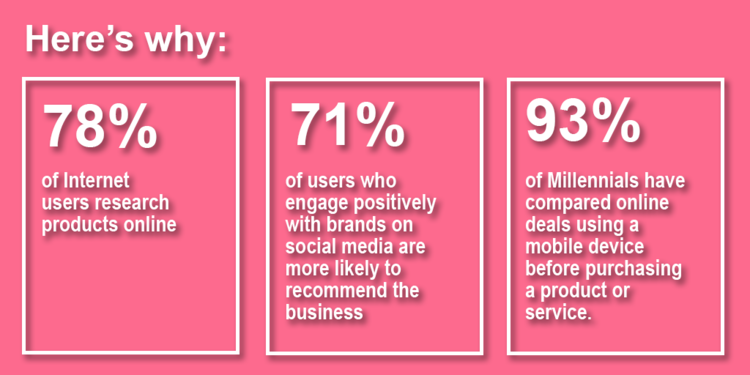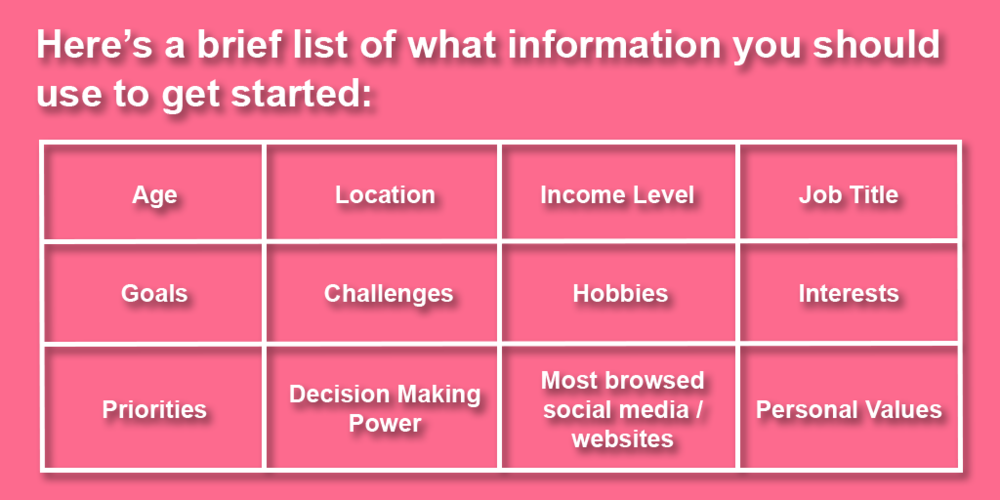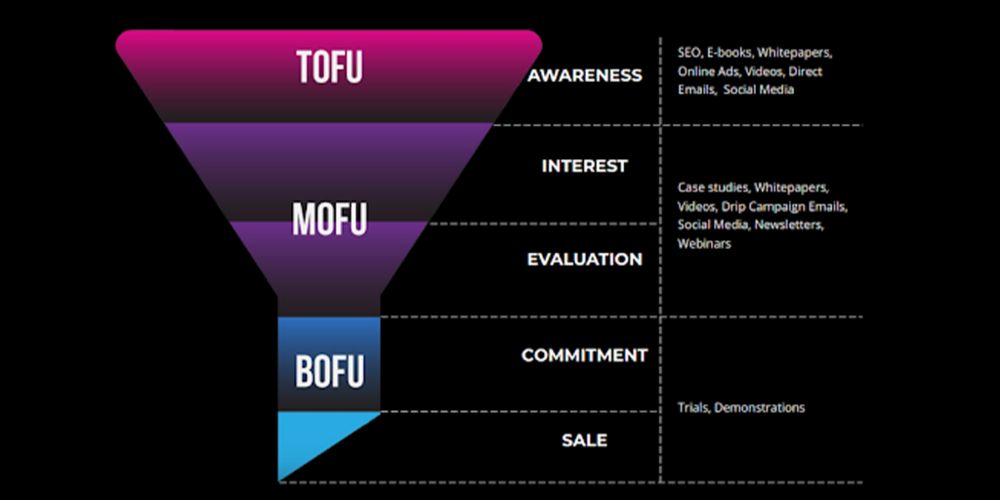Today, a strong digital marketing presence is crucial to the success of any business.

To turn prospects into customers, you should reach them at the most opportune moment where and when they are spending their time.
As you build your business, you may also get concerned over getting leads, sales, and retaining customers – which can distract you from your core business operations.
So the question is –
“How do business owners create an agile digital marketing strategy?”
We know, it sounds scary. But before we get into technical details, let’s clarify what a
“digital marketing strategy” is.
Digital Marketing Strategy vs Execution
Search Engine Optimization (SEO), Social Media Marketing, and Email Marketing.
You may be getting excited about these buzzwords, but they are just a few of many components to execute as part of a full digital marketing strategy.
In other words – they’re just tactics or campaign segments. Not a full-fledged strategy.
A solid digital marketing strategy should encompass three key ideas:
Search Engine Optimization (SEO), Social Media Marketing, and Email Marketing.
You may be getting excited about these buzzwords, but they are just a few of many components to execute as part of a full digital marketing strategy.
In other words – they’re just tactics or campaign segments. Not a full-fledged strategy.
1) A clear challenge your business is facing
It could be a need to improve online awareness, grow online sales, or maximise the value of your customer database.
2) What values guide your decision making in overcoming this challenge
This means prioritising and clarifying what direction to take. This is so you don’t get caught up doing what’s less important.
For example, a seasoned digital marketer might think:
“I’ve noticed people often add to cart, but they don’t check out. This hurts online sales growth. Maybe I should focus on ensuring they convert at the tail end”.
3) Clear actions to achieve your business goals
Here is where you start to develop tangible actions.
If you decide building a strong social media presence is important, this may include scheduling daily posts, and encouraging user generated content (UGC) for people to share their experiences with your brand.
These steps will keep you grounded if you ever feel lost in planning your digital marketing strategy.
So what is a digital marketing strategy?
In short:
A digital marketing strategy aims to fulfil business goals through specific channels, clear actions, with tangible results that can be evaluated.
Remember, things such as:
- Blogging
- Social media marketing
- Gated content
- SEO
- Online contests / giveaways
- Podcasts
- Email marketing
- Webinars
- Display ads
- Influencer marketing
…are all just components of a comprehensive strategy.

So what is a digital marketing strategy?
When you start applying these different tactics across channels in unison, they start to form a cohesive digital marketing campaign.
You could even plan to run multiple campaigns at any given time!
But before that, let’s talk about how you can kickstart your first digital marketing strategy.
Creating Your First Digital Marketing Strategy
- Build your buyer personas
- Identify your goals and the digital marketing tools you’ll need.
- Evaluate your existing digital channels and assets
- Audit and plan your owned media campaigns
- Identify your goals and the digital marketing tools you’ll need.
- Monitor and report.
1. Creating your buyer persona
‘Know thy customer’ is the first rule of marketing.
For your digital marketing strategy to take off, you need to know who you’re advertising to. This prospective customer comes in the form of a buyer persona.
Your buyer persona:
- Represents the ideal person you want to reach – as they’re the most likely to become your customer
- Is created from actionable data e.g age segments of prospects and even interest groups who are keen to engage your services or purchase your products
- Has clearly established desires, pain points, buying habits, and a clear decision-making process

Bear in mind, the depth and range of info will differ depending on if you’re a B2B or B2C company, and the type of products or services you offer.
It’s vital you create an accurate buyer persona, as this will dictate how you formulate the rest of your digital marketing strategy.
Of course, as the world and its trends shift, it may be necessary to revisit your buyer persona and readapt your strategy accordingly.
2. Establish clear digital marketing goals
As the saying goes, ‘if you fail to plan, your digital marketing strategy might fail”.
Your digital marketing goals should always relate back to your fundamental business goals, and the challenges you set out in the beginning.
At this stage, it may be key for you to prioritise where you want to concentrate your efforts in the marketing funnel:
If you’re not sure, why not get a free consultation from us?

For example, if you launched a new product, you may want to create interest in existing customers through email or social media.
Or, if you wanted to increase revenue through your e-commerce store by say – 15% – you might purchase more paid ads to directly reach actively searching customers.
Once you’ve listed out your goals, start prioritising, and you’ll know which part of your plan you should act on first.
Still confused? We’re happy to help.
Remember – always consider your buyer persona in the process, as this will impact how you approach them in your campaigns.
3. Evaluate your existing digital media assets and channels
A digital marketing strategy is still a broad vision. But once you get to this stage it is slightly easier to start zooming in.
It’s difficult to kickstart efforts from the ground up, so take inventory and consider your:
- Owned Media
Owned media simply put is,
- Content you own (website, social media profiles, blog)
- Content you share (ebooks, photos, or videos)
Owned media is immensely helpful in any inbound marketing efforts, where you establish yourself online and let yourself get discovered.
Specific digital marketing tactics for inbound marketing may include Search Engine Optimization (SEO) or driving traffic through social media.
- Paid Media
Paid media is what makes up the majority of many digital campaigns – as it allows brands to easily reach a wide audience they normally wouldn’t be able to.
This includes:
- Ads on social media platforms (Think, Facebook, Instagram, LinkedIn, TikTok)
- Search Ads (On Google, Bing etc)
- Native Ads (where ads appear within content on major sites)
- Marketplace Ads (Where B2C brands advertise on sites like Shopee / Lazada)
- Sponsored posts (Content communicated through influencers or industry-relevant websites)
Of course, paying in exchange for visibility online can get expensive quickly.
To prevent ineffective spending on paid media, be sure to nail down precisely what you need in terms of content to reach your buyer persona.
- Earned / Shared Media
Earned or shared media refers to the exposure you earn through third party sources.
User-generated content (When people post about your business on social media), or an article featuring your business all count as earned or shared media.
Other examples such as customer reviews, features on television, radio, or awards received are great in establishing social proof about your business – making such media key in your digital marketing strategy.
Now, let’s take a look at how these media assets play a part in executing your strategy.

PRACTICE SCENARIO:
You may have a particular blog post that has been regularly driving visitors to youre-commerce store.
In order to fully leverage this piece of content that converts well, you’d want to expand it into other media channels.
You could start by encouraging your customer base to actively share on social media, or start driving traffic to the post directly through paid ads.
This is a common example of how to tie your different media assets into a coherent campaign. You now can now comprehensively analyse how well the initial article performed:
- Are people likely to share it on social media?
- How well do cold audiences respond to your content? Do they convert at the tail end at your e-commerce store?
Of course at this stage, you’d have to start tracking and analysing the performance of such efforts – but we’ll touch on that later.
For now, we’ll go further in-depth into how you can leverage each type of media.
4. Building up owned media
A core part of your digital marketing strategy will be your owned media.
This is simply because everything you make available online is your brand communicating to the world.
- Your main website
- Your e-commerce site
- Social media pages
- Ebooks
- Infographics
- Webinars / video recordings
- Blog posts
- Infographics
…are all owned media!
Your owned media forms the foundation of your online presence.

When easily found through social media, other websites, and search engines, you make it easy for customers to find you and discover your value propositions.
A popular buzzword here is “SEO” or search engine optimization.
What this means is your website, or any other of your owned media is found to be relevant, useful, and easy to navigate to customers in the eyes of search engines like Google.
High SEO scores rank you higher on search engine result pages (SERP) on engines like Google.
Obviously, you want to be higher on such pages – the #1 result on Google gets 37% of all clicks.
But before you start going down the SEO rabbit hole, it’s important to determine how much-owned media will play a role in your digital marketing strategy.
(If you want more help with website SEO, we will give you a consultation for free!
If your goal is to build an email database of leads, you may not necessarily focus on optimising your website for popular keywords.
You might offer an attractive (and relevant) prize on a social media contest requiring participants to enter their email – driving them to your website to enter as part of the process.
To prioritise what owned media is important to your digital marketing strategy, follow this quick process.
- Evaluate content you already have
Look at what you already have developed, and rank them according to performance in relation to your existing goal.
If your goal is page views, look at how much traffic was generated from each social media post, ebook, or even infographic.
You want to know what clicks with your audience – so you can continue working on what’s proven and not waste time chasing down what your audience is disinterested in.
- ASK: “What is my content missing?”
Remember your buyer persona! Your content shouldn’t be different from what you would expect them to want.
If you’re selling bicycles, you wouldn’t hold a webinar based on how to pick the ideal tennis racket.
Pick a topic that interests them that you haven’t already addressed – preventing tire wear for example.
Test out this topic across different mediums. eBooks, Instagram stories, and articles are all just a few examples (Refer to our list above!)
- Develop a content calendar and development plan
Now you know what works, and what gaps you have in your owned media assets, start preparing to create more content with a simple plan outline.
You should include:
- Content topic
- Format (Article, social media post etc)
- What pain point you’re addressing
- How you’re promoting the content
- How urgent the content is (Is it a main page of your website? Or a single post?)
- When to post
- When to track results
Be sure to include other important details such as development deadlines and budgets – this will help you later on in planning the rest of your content.
5. Audit existing earned / shared media
Where do you stand in your industry? Are there brands you can collaborate with?
The aim of earned media is to get people buzzing about your product or services through the social proof provided by others.
By reaching out to people who are actively engaging in your content, you are potentially setting yourself up for a partnership marketing effort.
But remember – these efforts have to be relevant to your original digital marketing strategy goals! Don’t go around creating brand awareness when your goal is online sales.
An alternative to the example above may be to include a short CTA in your posts, so people can check out the brand behind the content they are enjoying.
6. Investing in paid media
Again, go back to your buyer persona and goals.
Where are your customers spending their time? If you’re targeting Instagram-obsessed millennials or Tik-Tok crazy Gen Zrs, you definitely want to be buying ads on those platforms.
If you’re targeting business owners, they might be browsing Facebook more often, or news sites such as The Wall Street Journal you’ll require a slight shift in your media buying.
Be sure to recall what you’ve tried out in the past!
If Google search ads have not been working, you may want to evaluate if you’ve already been bidding on the optimal keywords, or what improvements you can make to your existing strategy.
Remember, you should understand clearly what channels you’ve tested, and whether you want to continue utilising it, or adopt a new channel entirely.
Here’s where we come back to the idea of tracking and analysing.
With paid media, you can typically rely on platforms like Facebook to give you a rough idea of how the campaigns are performing.
However, your assets outside of these platforms such as your emails and website require a little more effort to consolidate all your data into something you can analyse.
This is where handy tools such as Google Analytics come in, where you can define what your assets are, how much traffic they receive, and which campaign efforts are contributing most to your digital marketing growth.
7. Unify your digital marketing efforts into a cohesive campaign
Now that you’re done evaluating your existing assets and planning new initiatives, you should have a clear roadmap for your digital marketing strategy.
Start connecting the dots between your owned, paid, and shared media – and how they play a role in your overall strategy.
Are they standalone efforts? Are you using paid media to drive traffic to your owned media? Are you using influencers in conjunction with your shared media?
There are limitless ways to approach your strategy. It’s important you do not lose focus of who you’re marketing to, and how you want to reach them.
REMEMBER:
- Formulate your digital marketing strategy first
- Develop accurate buyer personas
- Identify specific digital marketing goals
- Evaluate your existing owned, earned, and paid media
- Plan how you intend to utilise each channel
- Unify your efforts into an effective strategy
- Don’t lose focus of your goals, always go back to them and your buyer persona.
In A Nut Shell
Your digital marketing strategy document with all the info you’ve collected thus far will be pivotal in keeping your efforts grounded.
It forms the foundation of your digital marketing ecosystem, so stick to it and once you can visualise how you’re going to reach your goals, you have a clear digital marketing strategy.
Should you still need help in evaluating your strategy or any aspects of digital marketing, EpicNgage Media is offering a FREE 30 minutes consultation.
If you enjoyed this post, don’t forget to share it around, and we’ll see you in the next post!
